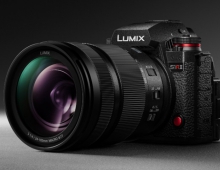
Panasonic Introduces 3-Megapixel Camera Module for the Mobile Terminal Market
Industry's thinnest 8.63 mm module incorporates auto-focus and image-stabilizer.
Panasonic SC Device Solutions Co., Ltd. (PSCDS), a subsidiary of Matsushita Electric Industrial Co., Ltd., today announced the development of a 3-megapixel camera module designed for mobile phones. With the latest v Maicovicon image sensor at the core, the module, GP-KM3500V, incorporates auto-focusing and image-stabilizing capabilities in the industry's thinnest 8.63mm package. The GP-KM3500V makes camera phones thinner while ensuring superb picture quality.
"Conventional 3-megapixel Charge Coupled Device (CCD) and CMOS image sensors are not small enough to design compact camera modules, resulting in bulky mobile phones. This new camera module successfully combines quality imaging with compact design by taking full advantage of the new 3-megapixel v Maicovicon that features the industry's smallest 2.2-micron pixel size. Advanced mounting and image processing technologies, as well as the ultra-mini focus actuator and thinner lenses, also contributed to reducing the size," said Mr. Satoru Masuda, Director of Engineering, PSCDS.
"This tiny package includes automatic focus in the range of approximately 8 cm to infinity and an image stabilizer for motion image recording. This makes taking quality picture very easy," he added.
In order to achieve the compact camera module, PSCDS integrated the sensor, an imaging digital signal processor (DSP), and the lens unit with an infra-red (IR) filter, in a three-dimensional electronic circuit board using Molded Interconnect Device (MID) technology. This integration allows high quality pictures with reduced ghosts and flares in the industry's thinnest camera module.
The high-resolution DSP was specifically designed for camera phones to optimize the performance of the new 3-megapixel image sensor. The chip delivers clear, vivid still pictures as well as corrects blurry images caused by camera-shake. The image stabilizer functions when taking video at a full rate of 30 frames per second at VGA resolution. The chip also controls the mechanical shutter and strobe. It is the result of Panasonic's expertise and experience in imaging technology.
Along with the 3-megapixel (1/3.2-inch optical format) module, Panasonic announced two new imaging modules: the 2-megapixel (1/3.2-inch optical format) camera module with auto-focus and the 1.3-megapixel (1/4-inch optical format) camera module with built-in macro zooming function.
The company plans to start volume production of the 3-megapixel and 2-megapixel modules in March 2005 and 1.3-megapixel module in January 2005.
Including current applications, Matsushita Electric Industrial Co., Ltd. owns 12 Japanese and nine overseas patents related to the camera modules.
PSCDS specializes in design, development, manufacture and sales of modular components related to audio, video and identification systems.
"Conventional 3-megapixel Charge Coupled Device (CCD) and CMOS image sensors are not small enough to design compact camera modules, resulting in bulky mobile phones. This new camera module successfully combines quality imaging with compact design by taking full advantage of the new 3-megapixel v Maicovicon that features the industry's smallest 2.2-micron pixel size. Advanced mounting and image processing technologies, as well as the ultra-mini focus actuator and thinner lenses, also contributed to reducing the size," said Mr. Satoru Masuda, Director of Engineering, PSCDS.
"This tiny package includes automatic focus in the range of approximately 8 cm to infinity and an image stabilizer for motion image recording. This makes taking quality picture very easy," he added.
In order to achieve the compact camera module, PSCDS integrated the sensor, an imaging digital signal processor (DSP), and the lens unit with an infra-red (IR) filter, in a three-dimensional electronic circuit board using Molded Interconnect Device (MID) technology. This integration allows high quality pictures with reduced ghosts and flares in the industry's thinnest camera module.
The high-resolution DSP was specifically designed for camera phones to optimize the performance of the new 3-megapixel image sensor. The chip delivers clear, vivid still pictures as well as corrects blurry images caused by camera-shake. The image stabilizer functions when taking video at a full rate of 30 frames per second at VGA resolution. The chip also controls the mechanical shutter and strobe. It is the result of Panasonic's expertise and experience in imaging technology.
Along with the 3-megapixel (1/3.2-inch optical format) module, Panasonic announced two new imaging modules: the 2-megapixel (1/3.2-inch optical format) camera module with auto-focus and the 1.3-megapixel (1/4-inch optical format) camera module with built-in macro zooming function.
The company plans to start volume production of the 3-megapixel and 2-megapixel modules in March 2005 and 1.3-megapixel module in January 2005.
Including current applications, Matsushita Electric Industrial Co., Ltd. owns 12 Japanese and nine overseas patents related to the camera modules.
PSCDS specializes in design, development, manufacture and sales of modular components related to audio, video and identification systems.





















